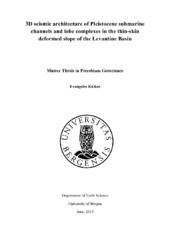| dc.description.abstract | The current study describes the architecture of Pleistocene-Holocene depositional features that is affected by the underlying structurally topography. The study area is located offshore Israel, at the Levantine Basin of the southeastern Mediterranean sea and is part of the eastern Nile's middle to lower submarine fan at depth of approximately 1200 m. The underlying topography in the study area is controlled by thin-skinned tectonic deformation resulted from the underlying mobile Messinian salt sequence. Previous work in the area of study has delineated several turbidite channel levee systems that are fed and has described in details qualitatively and quantitatively the most well illustrated depositional features in terms of interaction between the evolution of the depositional systems and the surrounding structures. This study is focused on the turbidite systems that have not been mentioned before or if they have been mentioned and they have not been described in details. The analysis of the data is based on the seismic interpretation of 3D HR seismic data and the extraction of attribute maps that cover an area of 1400 km2. Based on the attribute maps in combination with the seismic lines, qualitative and quantitative measurements took place for the main depositional elements of interesting, with the small scale lower submarine fan turbidite channel levee complexes to be the dominant sedimentary features in the area. The depositional system of the study consists of five different seismic Facies with Facies 1: channel fill deposits (HAR's), Facies 2: channel levee deposits, Facies 3: mass transport deposits, Facies 4: frontal splays or crevasse splay deposits (HARP's) and Facies 5: hemipelagic or sheet like turbidite deposits. The oldest system consists of a channel system while the most recent depositional feature is a turbidite channel system which ends up to frontal splay deposits. Based on the observations from the interaction between the depositional features and the deformed structures in the study area four models were created and an attempt to interpret external factors that control the stratigraphy of the Syn-tectonic sequence such as sea-level flunctuations took place. | en_US |
